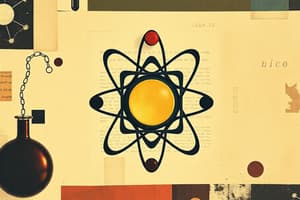Podcast
Questions and Answers
How many neutrons are present in a typical oxygen atom?
How many neutrons are present in a typical oxygen atom?
- 7
- 8 (correct)
- 6
- 5
What does the atomic number of an element represent?
What does the atomic number of an element represent?
- The number of neutrons in the atom
- The total number of electrons in the atom
- The total mass of the atom
- The number of protons in the atom (correct)
What is the atomic mass of chlorine and how many neutrons does it contain?
What is the atomic mass of chlorine and how many neutrons does it contain?
- 34 amu and 18 neutrons
- 35 amu and 17 neutrons
- 35 amu and 18 neutrons (correct)
- 34 amu and 17 neutrons
Why is the atomic mass unit not the actual mass of an atom?
Why is the atomic mass unit not the actual mass of an atom?
Which statement is true about the relationship between protons and electrons in a neutral atom?
Which statement is true about the relationship between protons and electrons in a neutral atom?
What is the correct definition of matter?
What is the correct definition of matter?
Which statement is true regarding atoms?
Which statement is true regarding atoms?
What distinguishes protons from neutrons?
What distinguishes protons from neutrons?
Which subatomic particles primarily determine the mass of an atom?
Which subatomic particles primarily determine the mass of an atom?
Why is it important to differentiate between mass and weight?
Why is it important to differentiate between mass and weight?
What defines an element in terms of atomic structure?
What defines an element in terms of atomic structure?
Which of the following statements is true about isotopes?
Which of the following statements is true about isotopes?
What is a radioisotope?
What is a radioisotope?
How is the decay rate of a radioisotope commonly expressed?
How is the decay rate of a radioisotope commonly expressed?
What happens to the identity of an element during a chemical reaction?
What happens to the identity of an element during a chemical reaction?
What is a distinguishing characteristic of all elements?
What is a distinguishing characteristic of all elements?
Which element is represented by the chemical symbol 'Na'?
Which element is represented by the chemical symbol 'Na'?
Which of the following best explains why elements cannot be broken down by chemical reactions?
Which of the following best explains why elements cannot be broken down by chemical reactions?
What does the atomic number of an atom represent?
What does the atomic number of an atom represent?
What is the maximum number of electrons that can occupy the first energy level?
What is the maximum number of electrons that can occupy the first energy level?
Which statement best describes electrically neutral atoms?
Which statement best describes electrically neutral atoms?
Which of the following statements about outermost energy levels is true?
Which of the following statements about outermost energy levels is true?
How many protons would an atom with 8 electrons contain?
How many protons would an atom with 8 electrons contain?
Which atom has a filled outer energy level and thus is very stable?
Which atom has a filled outer energy level and thus is very stable?
In which order do electrons fill energy levels?
In which order do electrons fill energy levels?
What is a characteristic of atoms that have unfilled outer energy levels?
What is a characteristic of atoms that have unfilled outer energy levels?
Which statement accurately describes lithium's electron configuration?
Which statement accurately describes lithium's electron configuration?
Which of the following atoms would be expected to be chemically stable?
Which of the following atoms would be expected to be chemically stable?
Why does hydrogen readily react with other atoms?
Why does hydrogen readily react with other atoms?
What is the maximum number of electrons that can be held in the second energy level of an atom?
What is the maximum number of electrons that can be held in the second energy level of an atom?
Which of the following atoms has an unfilled energy level and is very active?
Which of the following atoms has an unfilled energy level and is very active?
What are elements with filled outermost energy levels called?
What are elements with filled outermost energy levels called?
Which statement best describes the nature of reactive elements?
Which statement best describes the nature of reactive elements?
What type of bond is formed when atoms share electrons?
What type of bond is formed when atoms share electrons?
Which process contributes to the formation of ionic bonds?
Which process contributes to the formation of ionic bonds?
Which of the following is NOT a type of chemical bond?
Which of the following is NOT a type of chemical bond?
What charge does a sodium ion acquire after losing an electron?
What charge does a sodium ion acquire after losing an electron?
What is the primary reason chlorine gains an electron during the formation of sodium chloride?
What is the primary reason chlorine gains an electron during the formation of sodium chloride?
What type of bond is formed between the sodium ion and the chloride ion?
What type of bond is formed between the sodium ion and the chloride ion?
How do sodium and chloride ions interact in solid sodium chloride?
How do sodium and chloride ions interact in solid sodium chloride?
What is the main structural characteristic of sodium chloride crystals?
What is the main structural characteristic of sodium chloride crystals?
What is the primary purpose of the steps outlined in the content?
What is the primary purpose of the steps outlined in the content?
Which of the following is most likely a key consideration during STEP 1?
Which of the following is most likely a key consideration during STEP 1?
What might be the expected outcome from following STEP 3?
What might be the expected outcome from following STEP 3?
In a structured scientific inquiry process, what is an essential action during STEP 2?
In a structured scientific inquiry process, what is an essential action during STEP 2?
Which of the following would NOT typically be a focus during the inquiry process outlined?
Which of the following would NOT typically be a focus during the inquiry process outlined?
What type of bond is formed when two hydrogen atoms share a pair of electrons?
What type of bond is formed when two hydrogen atoms share a pair of electrons?
How many covalent bonds can a carbon atom form to achieve stability?
How many covalent bonds can a carbon atom form to achieve stability?
What is indicated by three lines between two nitrogen atoms in a molecule?
What is indicated by three lines between two nitrogen atoms in a molecule?
How does oxygen achieve a stable electron configuration?
How does oxygen achieve a stable electron configuration?
Which molecule is formed by the sharing of hydrogen atoms?
Which molecule is formed by the sharing of hydrogen atoms?
What occurs when an atom loses an electron?
What occurs when an atom loses an electron?
What is the result of adding an electron to a neutral atom?
What is the result of adding an electron to a neutral atom?
What type of bond is created by the electrical attraction between cations and anions?
What type of bond is created by the electrical attraction between cations and anions?
How does an electron donor function in the formation of an ionic bond?
How does an electron donor function in the formation of an ionic bond?
What occurs when an atom gains two electrons?
What occurs when an atom gains two electrons?
Flashcards are hidden until you start studying
Study Notes
Chemistry and Matter
- Chemistry is the study of matter's structure and the energy associated with its processes.
- Matter is anything that occupies space and has mass.
- Mass determines an object's weight under gravity, but mass remains unchanged regardless of location, such as in orbit.
- Atoms are the smallest stable units of matter, distinguished by the types of atoms and how they combine.
Subatomic Particles
- Atoms consist of three main types of subatomic particles: protons, neutrons, and electrons.
- Protons (positive charge) and neutrons (neutral charge) reside in the nucleus; electrons (negative charge) orbit around the nucleus.
- The mass of an atom is primarily determined by the count of protons and neutrons, largely ignoring the mass of electrons.
Elements and Isotopes
- Atoms are classified into elements based on atomic number; there are 92 naturally occurring elements, with additional ones created artificially.
- Each element has a unique chemical symbol often based on English or Latin names.
- Atomic number represents the number of protons; it uniquely identifies each element.
- Isotopes are variants of an element with the same number of protons but differing numbers of neutrons, impacting their mass number.
- Radioisotopes are isotopes that emit radiation, with a decay rate expressed in terms of half-life.
Atomic Structure and Mass
- For example, an oxygen atom (atomic number 8) has 8 protons and usually 8 neutrons, leading to a mass number of 16.
- Chlorine (atomic number 17) has 17 protons and typically 18 neutrons, resulting in a mass number of 35.
- Atomic weight reflects the actual mass of an atom, while mass numbers provide a count of subatomic particles.
Electron Shells and Energy Levels
- Electrons occupy electron shells, with each energy level holding a specific maximum number of electrons (2 in the first level, 8 in the subsequent levels).
- Atoms are generally electrically neutral by having equal numbers of protons and electrons.
- The stability of an atom is determined by the fullness of its outermost energy level; unfilled levels lead to reactivity.
Chemical Bonds
- Inert elements (e.g., helium, neon) have filled outer energy levels and do not readily react; these are termed noble gases.
- Reactive elements (e.g., hydrogen, lithium) tend to achieve stability by gaining, losing, or sharing electrons, forming three main types of bonds: ionic, covalent, and hydrogen bonds.
Ionic Bonds
- Ionic bonds form between positively charged ions (cations) and negatively charged ions (anions).
- An atom becomes a cation by losing electrons and an anion by gaining electrons.
- An example of ionic bonding is sodium chloride (NaCl), where sodium loses one electron to become Na⁺ and chlorine gains an electron to become Cl⁻, resulting in an ionic compound.
Covalent Bonds
- Atoms can achieve stable outer shells by sharing electrons, forming covalent bonds.
- Molecular hydrogen (H₂) forms from the sharing of one pair of electrons.
- Oxygen forms double covalent bonds with two shared pairs of electrons in O₂.
- Carbon, with four electrons in its outer shell, can form up to four covalent bonds to achieve stability.
Conclusion
- Understanding atomic structure, bonding, and the role of electrons is fundamental in chemistry, influencing both the reactions that occur and the properties of materials.
Studying That Suits You
Use AI to generate personalized quizzes and flashcards to suit your learning preferences.




